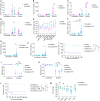Fluoxetine promotes IL-10-dependent metabolic defenses to protect from sepsis-induced lethality
- PMID: 39951524
- PMCID: PMC11827869
- DOI: 10.1126/sciadv.adu4034
Fluoxetine promotes IL-10-dependent metabolic defenses to protect from sepsis-induced lethality
Abstract
Selective serotonin reuptake inhibitors (SSRIs) are some of the most prescribed drugs in the world. While they are used for their ability to increase serotonergic signaling in the brain, SSRIs are also known to have a broad range of effects beyond the brain, including immune and metabolic effects. Recent studies have demonstrated that SSRIs are protective in animal models and humans against several infections, including sepsis and COVID-19; however, the mechanisms underlying this protection are largely unknown. Here, we mechanistically link two previously described effects of the SSRI fluoxetine in mediating protection against sepsis. We show that fluoxetine-mediated protection is independent of peripheral serotonin and instead increases levels of circulating interleukin-10 (IL-10). IL-10 is necessary for protection from sepsis-induced hypertriglyceridemia, preventing cardiac effects including impairment of glucose oxidation, ectopic lipid accumulation, ventricular stretch and possibly cardiac failure. Our work reveals a beneficial "off-target" effect of fluoxetine, and reveals a protective immunometabolic defense mechanism with therapeutic potential.
Figures







References
-
- Singer M., Deutschman C. S., Seymour C. W., Shankar-Hari M., Annane D., Bauer M., Bellomo R., Bernard G. R., Chiche J., Coopersmith C. M., Hotchkiss R. S., Levy M. M., Marshall J. C., Martin G. S., Opal S. M., Rubenfeld G. D., van der Poll T., Vincent J., Angus D. C., The Third International Consensus Definitions for Sepsis and Septic Shock (Sepsis-3). JAMA 315, 801–810 (2016). - PMC - PubMed
-
- Fisher C. J., Recombinant human interleukin 1 receptor antagonist in the treatment of patients with sepsis syndrome: Results from a randomized, double-blind, placebo-controlled trial. JAMA 271, 1836–1843 (1994). - PubMed
MeSH terms
Substances
Grants and funding
LinkOut - more resources
Full Text Sources
Medical
Molecular Biology Databases

